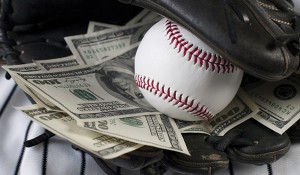Baseball isn’t just a great sport to play and watch – it’s also an economic engine. Cities often help major league teams to build stadiums in hopes of boosting economic activity in the surrounding neighborhoods. But there’s one ingredient that really brings in the bucks: a winning team.
Back in 1994, the Maricopa County Board of Supervisors voted for a quarter-point increase in the sales tax to fund what is now Chase Field. And in 2021, the state government decided to allow a 9% tax on sales in the stadium to fund a renovation. The idea behind these measures was that the ball club would pull more business not just into the stadium but also into Downtown Phoenix as a whole.
Chase Field can host more than 48,000 fans, but the average attendance last season was less than 20,000. That figure wasn’t just low; it was 20% lower than any season prior to the pandemic. Spending $500 million to refurbish the stadium might bring in more fans, but winning more games could have a similar effect.
The Value of Winning
At least that’s the suggestion of our new research on the relationship between results on and off the field. As a leading online marketplace for flexible work, my company is heavily involved in staffing for stadiums and local businesses in most of the major league markets. We carry all the transactions on our platform, so we know how demand for labor changes for each business over the course of the baseball season.
Recently, we posted an analysis showing that markets with playoff clubs experienced big upticks in labor demand toward the end of the 2022 baseball season. In each market, we measured the total demand in the one-mile radius around each stadium for businesses that posted shifts throughout the season. We tracked demand month-by-month across the entire area.
On average, we found that markets where teams made the playoffs had much larger increases in labor demand during the last months of the season than markets where teams fell short. In fact, demand in September was more than 50% higher in playoff markets than it had been in April. The average increase in markets without playoff teams was just over 10%.
As an example, businesses in the vicinity of the Rogers Centre in Toronto posted more than double the shifts in September that they had in April as the Blue Jays compiled a 92–70 record on their way to the playoffs. Attendance also rose by about 5,000 fans per game by August last year. And the average hourly rate paid to flexible workers in the area fell slightly, possibly an indication that more workers were feeling the playoff fever.
By contrast, demand for flexible labor around Chase Field fell by about half between April and June 2022. By September, it had recovered to only about 75% of the April total. Hourly pay was steady and, for the most part, attendance was as well.
There was a slight uptick averaging about 2,000 fans per game at the end of the season, coinciding with the recovery in shift volumes. Yet at this point, average shift volumes across all our playoff markets were 50% higher than in April. The winners on the field were winning off it as well.
The Cost of Winning
Last season, the Diamondbacks went 74–88, finishing 37 games behind the dominant Dodgers. The Dodgers were so far out in front that hopes of winning the division probably seemed very far off even early in the season. By the All-Star Break, the Diamondbacks were already under .500, so the chances of a wildcard spot were slim as well.
Improving on these results will probably cost money, maybe even as much as renovating a stadium. The Diamondbacks’ payroll in 2022 was about $86 million, versus $177 million for the Blue Jays and $270 million for the 111-win Dodgers. For an extra $500 million, the Diamondbacks could fund the Blue Jays’ payroll — and a fighting chance of making the playoffs — for five years.
To be sure, any benefit from renovating the stadium will probably last longer than that. There’s even some evidence that new stadiums help baseball teams to win a few more games. But eventually, even the best stadium needs a winning team to put rear ends in seats. It just so happens that the same winning team can put dollars into the local economy, too.
Daniel Altman is chief economist at Instawork.

















Speak Your Mind
You must be logged in to post a comment.